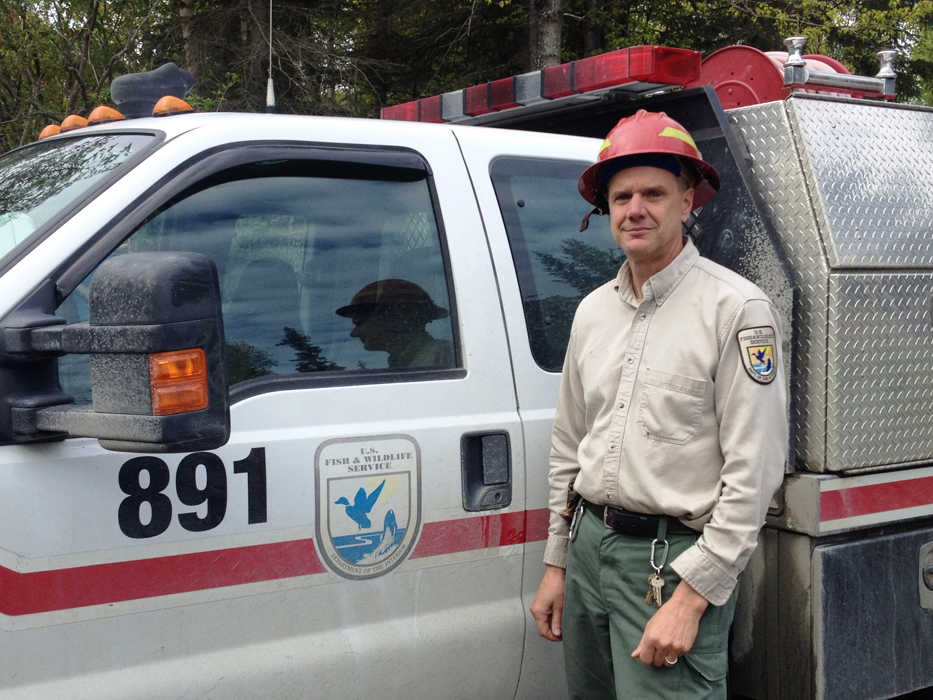It was a warm, windy day in southern New Mexico in the 1940s when a small bear cub was rescued from a wildfire. With burned paws he was clinging to a tree when firefighters spotted the cub and took him to a local veterinarian. The frightened cub had his burns cleaned and soon made a full recovery but, unfortunately, the cub was unable to be released back into the wild. However, this bear had a higher calling. Of course we all know his name, “Smokey Bear,” but what does this have to do with the Kenai Peninsula?
Well, first of all, Smokey Bear and Kenai National Wildlife Refuge are nearly the same age. Smokey will turn 72 in July and the Refuge celebrates its 75th anniversary this year.
But, more importantly, the Kenai Peninsula has had some very serious wildfires recently, most notably the 2014 Funny River Fire and 2015 Card Street Fire. And in my new job at the Kenai Refuge as a “Fire Prevention and Mitigation Specialist,” I am, in a nutshell, “Smokey’s helper.” As Smokey’s helper, I provide you (the public) with information on how to prevent wildfires and make your property more resilient to fire damage, by clearing and thinning vegetation that could feed a wildfire. Referred to as “defensible space,” this is the area cleared of flammable vegetation that could carry a wildfire right up to the home. Defensible space also provides firefighters with a safer place to work when they are trying to protect a home from an approaching fire.
During the Card Street Fire, I was able to realize first-hand how important it is to have defensible space around a home. The Card Street Fire had been burning for a few days when it progressed northeast of Bottenintnin Lake toward the Skilak Guard Station. Fortunately, in previous years, Kenai Refuge staff had removed many black spruce trees around the Guard Station. This tree culling proactively created defensible space that provided my fire crew an area where we could set up water tanks, pumps and sprinklers to protect this historic structure.
As the wildfire came churning through the tops of the trees, the fire crew started the pumps and retreated to a safer area near Hidden Lake. Although the fire ultimately reached the cabin clearing, the defensible space coupled with the moisture from the pumps and sprinklers prevented the fire from burning right up to the structure. Forethought and action not only prevented damage to the Guard Shack itself, but also minimized mortality of the remaining birch and spruce trees.
Fire education is another aspect of my new position here at the Kenai Refuge. Since March, I have assisted Alaska State Forestry with fire prevention outreach in schools and with events such as the “Home Show” last spring. Last week, through the University of Alaska, we hosted an ecology field trip from Elmira College in New York State that allowed students to examine the effectiveness of hazardous vegetation (fuels) reductions, as well as look at the post-fire effects and overall habitat ecology of the Funny River Fire. This summer and fall, I will be coordinating Firewise Workshops with local communities.
These educational opportunities will hopefully increase the understanding about the necessary role that some wildland fires have in maintaining a healthy fire-resilient ecosystem for plants, animals and humans that share the Kenai Peninsula. Certain plant and animal species rely on the effects of wildland fire to make the environment more hospitable for their regeneration and growth. Providing information about the natural role that fire plays in the ecosystem, while encouraging people to be fire aware and do all they can to help prevent unwanted wildland fires, will be a challenging part of my job here on the peninsula.
In my career, I have been stationed all over the country in some of the most beautiful places in the Lower 48. However, nothing compares to Alaska, with its mountain glaciers, turquoise-colored rivers, black spruce bogs, and wetlands filled with ample wildlife. As a kid, I remember relaxing around campfires and feeling the warmth of the embers while socializing with family and friends. After all those years from then to now — since transferring from northern Minnesota to the Kenai — I again feel the same warmth from both the beauty of the Kenai landscape and the friendliness of its people.
Linden (Lindy) McNeilus is the new Fire Prevention and Mitigation Specialist for Alaska Southern Refuges. Find more information at http://www.fws.gov/refuge/kenai/ or http://www.facebook.com/kenainationalwildliferefuge.

